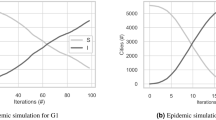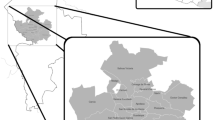Abstract
Child trafficking leads to family tragedies and social problems, and is a serious concern for social sustainability globally, particularly in China where tens of thousands of children are trafficked every year. Here, we used a new database and a set of network indicators to identify and target key cities and trafficking paths to help effectively break up child-trafficking networks in China. Special emphasis was placed on city-level networks. We observed that the majority of key cities were provincial capitals or located in Fujian province. Although the key paths were often between capitals and non-capitals, the top-ranked paths only controlled a small share of trafficking. Information dissemination and proactive crime fighting operations could reach over 80% of the network from just four of the selected cities. Based on our analysis, we propose new strategies for preventing illegal trafficking and adoption of children. This analytical strategy can also be useful to study other transferring activities of relevance for sustainability, such as the trafficking of adults, wildlife or waste.
This is a preview of subscription content, access via your institution
Access options
Access Nature and 54 other Nature Portfolio journals
Get Nature+, our best-value online-access subscription
$29.99 / 30 days
cancel any time
Subscribe to this journal
Receive 12 digital issues and online access to articles
$119.00 per year
only $9.92 per issue
Buy this article
- Purchase on Springer Link
- Instant access to full article PDF
Prices may be subject to local taxes which are calculated during checkout



Similar content being viewed by others
References
O'Connell Davidson, J. Moving children? Child trafficking, child migration, and child rights. Crit. Soc. Policy 31, 454–477 (2011).
Zhang, Z. Two hundred thousand children lost in China, information isolation is the biggest obstacle. China Youth Daily (31 August 2015); http://www.xinhuanet.com/info/2015-08/31/c_134572911.htm
Tao, L. Characteristics and prevention of child trafficking crime—based on 200 written judgements. Youth Juv. Res. 05, 19–24 (2017).
Wang, X. The situation and countermeasure of the crime of abducting and trafficking children. J. People Pub. Secur. Univ. China Soc. Sci. 5, 21–31 (2015).
Xing., H., Chen., R. & Xu., F. The developing characteristics of child trafficking crime—based on 447 written judgements. Juv. Delinq. Prev. Res. 01, 38–43 (2017).
Jiang, Q. & Sánchez-Barricarte, J. J. Child trafficking in China. China Rep. 49, 317–335 (2013).
Lee, J. J. Human trafficking in East Asia: current trends, data collection, and knowledge gaps. Int. Migr. 43, 165–201 (2005).
Shen, A., Antonopoulos, G. A. & Papanicolaou, G. China’s stolen children: internal child trafficking in the People’s Republic of China. Trends Organ. Crim. 16, 31–48 (2012).
Yang, J.-B. On the crime of abduction and sale of women and infants. Mod. Law Sci. 26, 74–80 (2005).
Cai, X.-L. Penalties configuration and panelties distribution of crime of child trafficking. Soc. Sci. Beijing 7, 13–26 (2016).
Mahmoud, T. O. & Trebesch, C. The economics of human trafficking and labour migration: micro-evidence from Eastern Europe. J. Comp. Econ. 38, 173–188 (2010).
Cockbain, E., Brayley, H. & Laycock, G. Exploring internal child sex trafficking networks using social network analysis. Policing 5, 144–157 (2011).
Dubrawski, A., Miller, K., Barnes, M., Boecking, B. & Kennedy, E. Leveraging publicly available data to discern patterns of human-trafficking activity. J. Hum. Traffick. 1, 65–85 (2015).
Tyldum, G. Limitations in research on human trafficking. Int. Migr. 48, 1–13 (2010).
Tyldum, G. & Brunovskis, A. Describing the unobserved: methodological challenges in empirical studies on human trafficking. Int. Migr. 43, 17–34 (2005).
Reino, L. et al. Networks of global bird invasion altered by regional trade ban. Sci. Adv. 3, e1700783 (2017).
Patel, N. G. et al. Quantitative methods of identifying the key nodes in the illegal wildlife trade network. Proc. Natl Acad. Sci. USA 112, 7948–7953 (2015).
Massari, M. & Monzini, P. Dirty businesses in Italy: a case-study of illegal trafficking in hazardous waste. Glob. Crime 6, 285–304 (2006).
Lepawsky, J. The changing geography of global trade in electronic discards: time to rethink the e-waste problem. Geogr. J. 181, 147–159 (2014).
Weitzer, R. New directions in research on human trafficking. Ann. Am. Acad. Polit. Soc. Sci. 653, 6–24 (2014).
Wei, W.-Q. & Liu, Z. How informal system affects policy implementation in the context of the conflict: lineage networks versus birth control policy in rural China. Sociol. Rev. China 5, 23–35 (2017).
Zhang, C. & Ma, G. Clan culture, son preference and the development of women in China. J. World Econ. 3, 122–143 (2017).
Li, G., Tan, R., Wang, H., Yan, X. & Shao, Y. Geographic characteristics of child trafficking crime in China. Sci. Geogr. Sinica 37, 1049–1058 (2017).
Blondel, V. D., Guillaume, J.-L., Lambiotte, R. & Lefebvre, E. Fast unfolding of communities in large networks. J. Stat. Mech. 2008, P10008 (2008).
Borgatti, S. P. Identifying sets of key players in a social network. Comput. Math. Organ. Theor. 12, 21–34 (2006).
Griffin, T. An empirical examination of AMBER Alert ‘successes’. J. Crim. Justice 38, 1053–1062 (2010).
Krzywinski, M. et al. Circos: an information aesthetic for comparative genomics. Genome Res. 19, 1639–1645 (2009).
Bastian, M., Heymann, S., & Jacomy, M. Gephi: an open source softeware for exploring and manipulating networks. In Proc. Third Int. ICWSM Conf. 361–362 (AAAI, 2009).
de Nooy, W., Mrvar, A. & Batagelj, V. Exploratory Social Network Analysis with Pajek: Revised and Expanded (Cambridge Univ. Press, New York, NY, 2011).
Opsahl, T., Agneessens, F. & Skvoretz, J. Node centrality in weighted networks: generalizing degree and shortest paths. Soc. Netw. 32, 245–251 (2010).
Girvan, M. & Newman, M. E. J. Community structure in social and biological networks. Proc. Natl Acad. Sci. USA 99, 7821–7826 (2002).
Bounova, G. & de Weck, O. Overview of metrics and their correlation patterns for multiple-metric topology analysis on heterogeneous graph ensembles. Phys. Rev. E 85, 290–11 (2012).
Feingold, D. A. Human trafficking. Foreign Policy 150, 26–30 (2005).
Acknowledgements
The authors thank Y. Han of Huazhong University of Science and Technology for her suggestions.
Author information
Authors and Affiliations
Contributions
Z.W. and L.D. designed this study. Z.W. analysed the data and wrote the manuscript. L.W. collected the data. S.P. prepared and pre-analysed the data. B.N. visualised the data. All authors evaluated the results.
Corresponding author
Ethics declarations
Competing interests
The authors declare no competing interests.
Additional information
Publisher’s note: Springer Nature remains neutral with regard to jurisdictional claims in published maps and institutional affiliations.
Supplementary information
Supplementary Information
Supplementary Figs 1–4, Tables 1–3, Discussions 1–3 and References
Rights and permissions
About this article
Cite this article
Wang, Z., Wei, L., Peng, S. et al. Child-trafficking networks of illegal adoption in China. Nat Sustain 1, 254–260 (2018). https://doi.org/10.1038/s41893-018-0065-5
Received:
Accepted:
Published:
Issue Date:
DOI: https://doi.org/10.1038/s41893-018-0065-5
This article is cited by
-
Knowledge mining and social dangerousness assessment in criminal justice: metaheuristic integration of machine learning and graph-based inference
Artificial Intelligence and Law (2023)
-
Mapping the Illegal International Ivory Trading Network to Identify Key Hubs and Smuggling Routes
EcoHealth (2020)
-
Unravelling child trafficking routes
Nature Sustainability (2018)



